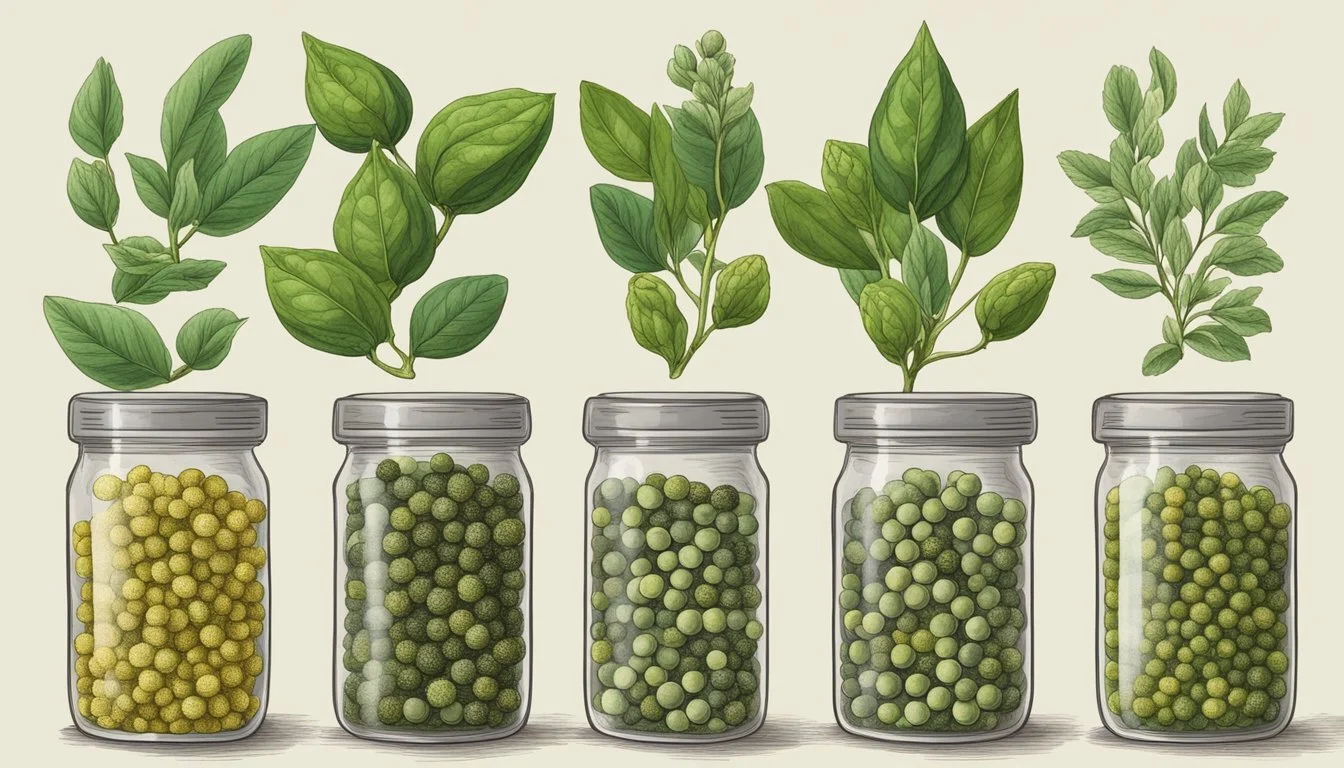Green Peppercorns Substitutes
Top Alternatives for Cooking
When you’re in the middle of preparing a dish and realize you’re out of green peppercorns, it can be frustrating. Luckily, several substitutes can easily fill in. White peppercorns make an excellent 1:1 substitute for green peppercorns due to their similar mild flavor.
Black peppercorns, though slightly bolder and more pungent, can also serve as a substitute. If sourcing whole white peppercorns proves challenging, capers can add a piquant, sour touch to your recipe, enhancing the overall flavor profile. Dried pink peppercorns can be another creative alternative with their unique, slightly sweet taste.
Other options include green olives, which, while lacking the peppery bite, add a salty undertone and work particularly well in kids' recipes. Each of these alternatives offers a unique spin, making it easier to maintain the intended flavor nuances in your dish.
Understanding Green Peppercorns
Green peppercorns are an integral spice known for their unique flavor, usage in diverse cuisines, cultivation regions, and health benefits.
Native Regions and Cultivation
Green peppercorns come from the Piper nigrum plant, native to regions of India and other parts of Southeast Asia. These regions offer the humid tropical climate ideal for growing this plant.
The peppercorns are harvested while still unripe, maintaining their green color. They are often preserved in brine or vinegar to keep their fresh appearance and flavor.
Early stages in the harvesting process are crucial to avoiding the development of the peppers into black or white varieties. Proper care during cultivation ensures a high-quality, flavorful spice.
Culinary Uses
Green peppercorns are highly valued in cooking for their mild, slightly spicy flavor. These peppercorns are a staple in classic French dishes like steak au poivre.
They add depth to rich sauces, especially cream-based ones. In Thai cuisine, they are used both whole and ground to enhance the flavor profile of dishes.
Their unique taste complements meats, vegetables, and even some seafood dishes. Flexibility in various cuisines makes green peppercorns a versatile addition to any kitchen.
Key Characteristics
Green peppercorns are known for their complex flavor and distinct texture. They possess a slightly spicy taste with a sharp heat that is milder compared to black pepper.
The peppers are the unopened flower buds of the Piper nigrum plant, giving them a unique green coloration. When preserved, they maintain a fresh, vibrant taste that adds both flavor and visual appeal.
Their mildness allows them to be used generously without overpowering other ingredients.
Health Benefits
Green peppercorns offer several health benefits due to their nutrient content. They are rich in antioxidants, which help protect the body from free radical damage.
Additionally, they contain important minerals such as iron, which is essential for oxygen transport in the blood. Vitamins present in green peppercorns support immune function and overall health.
Regular consumption can contribute to improved digestion and enhanced metabolism, making them not only a tasty addition to meals but a beneficial one as well.
Primary Substitutes for Green Peppercorns
or those looking for alternatives to green peppercorns, several substitutes can provide similar flavor profiles or unique twists to dishes. Each substitute offers distinctive characteristics, from robust heat to mild earthiness.
Black Peppercorns
Black peppercorns are the most common and widely used peppercorns. They bring a robust and pungent flavor with sharper heat compared to green peppercorns. These qualities make them an ideal substitute when you want to enhance the spiciness of a dish.
Crushed or whole, black peppercorns can be used in equal amounts as green peppercorns. They are often used in steaks, sauces, and marinades, providing a bold, spicy kick. Given their availability, black peppercorns are both convenient and effective substitutes.
White Peppercorns
White peppercorns offer a milder flavor profile compared to black peppercorns. They are made by soaking ripe berries to remove their dark skins, which results in a mellow, earthy taste. This makes them suitable for dishes where a subtle heat is desirable without overpowering the other ingredients.
White peppercorns can replace green peppercorns in a 1:1 ratio. They are often used in light-colored dishes like soups and sauces to maintain a consistent appearance. Whole white peppercorns can sometimes be challenging to find, but ground versions are readily available.
Pink Peppercorns
Pink peppercorns are not true peppercorns but come from a different plant family. They have a sweet, mild, and floral flavor, distinct from the typical pepper heat. This makes them ideal for adding a subtle, aromatic twist to dishes.
They can replace green peppercorns in equal amounts, especially in recipes that benefit from their mild and citrus-like notes. Pink peppercorns work well in salads, fish dishes, and creamy sauces. They also add a unique visual appeal with their vibrant color.
Capers
Capers provide a tangy and tart flavor, offering a different but complementary profile compared to peppercorns. Their briny taste makes them suitable for recipes that can accommodate a bit of saltiness and piquancy.
Chopped capers can be used as a substitute, especially in sauces, salads, and roasted vegetables. While they don't add the peppery heat, their distinctive taste can enhance the overall flavor profile of various dishes. For best results, use capers in similar quantities to the green peppercorns they replace.
Brined Substitutes
When seeking alternatives to green peppercorns in brine, brined black peppercorns and green olives offer distinct flavors and textures that can enhance various dishes.
Brined Black Peppercorns
Brined black peppercorns provide a notable alternative due to their bold flavor and briny taste. Soaked in a brine solution, these peppercorns maintain their robust peppery heat while adding a tangy and salty dimension. This makes them particularly suitable for recipes where a pronounced pepper flavor is desired.
The brining process softens the black peppercorns, allowing them to blend well with other ingredients without dominating the dish. They can be used in equal amounts to green peppercorns in brine, making the substitution straightforward.
Green Olives
Green olives stand out as a brined substitute with their unique characteristics. While lacking the peppery heat of green peppercorns, green olives contribute a salty, tangy flavor that enhances various dishes. Their firm texture and briny taste can complement dishes, particularly those where the pepper flavor is less critical.
This alternative works well in recipes that require a touch of saltiness and an additional layer of flavor. Chopped green olives are also visually pleasing, making them an excellent choice for garnishing and adding flair to presentations.
Other Creative Substitutes
For those seeking unique alternatives to green peppercorns, dried pink peppercorns and papaya seeds offer intriguing flavor profiles and potential benefits. These substitutes can elevate your dishes with different yet complementary tastes.
Dried Pink Peppercorns
Dried pink peppercorns offer a distinctive, slightly sweet flavor with a hint of spice. They are notably milder and less pungent than traditional black or green peppercorns.
These berries, derived from the Peruvian Peppertree, can be used in a variety of dishes, adding a delicate yet exotic touch. For best results, use dried pink peppercorns in moderation to preserve their subtle notes.
Their bright color also makes them visually appealing, enhancing the presentation of salads, sauces, and seafood dishes.
Papaya Seeds
Papaya seeds, often overlooked, can be ground and used as a peppercorn substitute. They bring a sharp, slightly peppery flavor that's reminiscent of black pepper but milder and more complex.
These seeds also offer health benefits, such as digestive enzymes that can aid in digestion. To use papaya seeds, clean and dry them before grinding.
Sprinkle ground papaya seeds over salads, meats, or soups to add a unique, pepper-like flavor. Their tropical origin and health benefits make them a fascinating and practical alternative in culinary applications.
Substitute Application and Pairing
For those who seek alternatives to green peppercorns, it's crucial to identify suitable substitutes for different dishes. Whether it's seafood, poultry, meat, vegetables, or pasta, certain substitutes can elevate the flavors and meet the desired culinary requirements.
Seafood Dishes
For seafood dishes, capers and white peppercorns are excellent substitutes. Capers work well due to their tangy and salty flavor. They pair beautifully with fish, bringing a briny punch that complements the delicate nature of seafood.
White peppercorns, with their milder and earthy profile, provide the needed spice without overpowering the dish. They're particularly effective in creamy seafood sauces, preserving the dish's creamy texture while adding a subtle bite.
Popular Pairings:
Grilled Fish with Capers
Creamy Shrimp Pasta with White Peppercorns
Poultry and Meat
When it comes to poultry and meat dishes, white peppercorns and black peppercorns are commonly used. White peppercorns offer a lightly spiced taste that enhances chicken dishes, especially in recipes requiring a more subdued seasoning profile.
Black peppercorns, known for their bold and pungent flavor, are a classic choice for meat dishes like steak au poivre. They add a sharp heat that pairs well with the rich, savory taste of meats. Using a blend can provide a balanced spicy flavor.
Popular Pairings:
Chicken Piccata with White Peppercorns
Steak au Poivre with Black Peppercorns and White Peppercorns Blend
Vegetable and Pasta Dishes
Substitutes like capers, black peppercorns, and white peppercorns are versatile for vegetable and pasta dishes. Capers add a salty and tangy flavor, perfect for roasted vegetables or vegetable salads, providing a burst of umami.
Black peppercorns can introduce a stronger heat and complement hearty vegetable dishes. White peppercorns offer a smoother spiciness, making them ideal for creamy pasta dishes where a milder spice is preferred.
Popular Pairings:
Roasted Vegetables with Capers
Creamy Alfredo Pasta with White Peppercorns
Ratatouille with Black Peppercorns
Using these substitutes effectively will enhance the flavors and seasoning profile of your dishes while maintaining the desired culinary balance.
Considerations for Substituting Peppercorns
When substituting peppercorns, it is crucial to factor in both possible allergies and the precise flavor profile matching.
Allergies and Dietary Restrictions
Some individuals might have allergies to piperine, the compound found in peppercorns responsible for their pungency.
Pepper allergy: This can be particularly severe for some, leading to symptoms such as itching, hives, or gastrointestinal issues. For these individuals, non-pepper substitutes like capers or a blend of safe spices could be suitable.
In addition, some dietary restrictions may require avoiding certain spices. For example, someone following a low-sodium diet should avoid high-sodium alternatives like capers in brine. Always check for any potential allergens or dietary conflicts when choosing a substitute.
Flavor Profile Matching
Matching the flavor profile is also essential when selecting a peppercorn substitute.
Green peppercorns have a milder, more fruity flavor compared to black peppercorns, which are bolder and more pungent. White peppercorns offer an earthy, slightly fermented taste and are mild, making them a close match in many recipes.
For those seeking a different yet complementary flavor, pink peppercorns offer a mild, slightly sweet taste. Dried pink peppercorns and ground white pepper can be good alternatives but ensure to use equal amounts for substitution to maintain balance. Using the right substitute ensures the intended taste of the dish is preserved.







